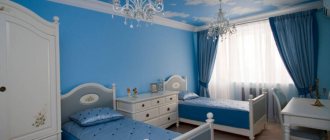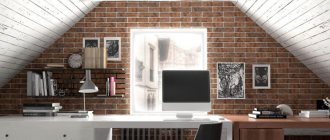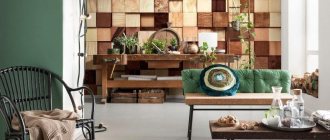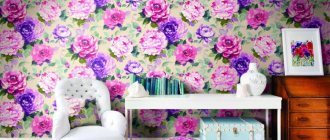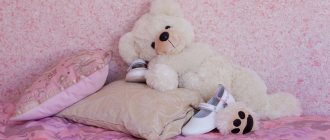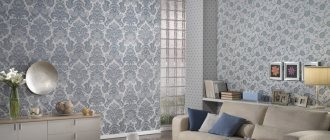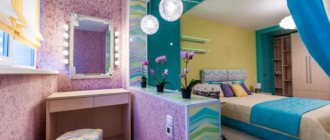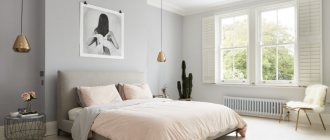Advantages of brick wallpaper
Of course, a wall made of natural brick is highly reliable, durable, environmentally friendly and safe. Despite this, masonry has some significant disadvantages, which relate not only to financial costs.
A brick wall “steals” the area of a room due to its thickness. She is also very cold (she emanates coolness). The wall surface needs special care, which becomes even more labor-intensive if there are any flaws on it. It must be taken into account that not every structure can withstand the weight of natural brick.
It turns out that brick-look wallpaper in the interior is a profitable and practical alternative to natural material, as it has many advantages:
- to work with them you do not need to involve a professional or have special skills;
- they do not overload the walls with their weight, thanks to which they can even be used to cover plasterboard partitions;
- it is possible to finish a section of a wall of any geometric shape, even with corners, bends, niches and protrusions of various types;
- The variety of wallpaper colors is not comparable to the number of natural colors of brick. It is possible to decorate the room not only in classic terracotta tones, but also in any shade that suits the interior;
- Simple wallpaper care involves periodic wet cleaning (wiping) with a sponge or brush.
What is the advantage of wallpaper with brick imitation?
Only a few rooms can boast of a real brick wall, and often this building material is covered with plaster, which is labor-intensive to remove. It is not advisable to erect a new brick layer, as it will make the structure heavier and steal space.
As an alternative, you can use tiles, facing bricks or patterned wallpaper. The latter option has several advantages.
- Wallpaper is the most budget option.
- They are the easiest way to cover the walls yourself.
- It takes a little time to hang the wallpaper and dry the glue.
- They do not create additional load on the walls and ceilings, and also will not eat up space.
- If necessary, the wallpaper can be easily removed.
- This material is not cold, unlike natural brick. This is especially true for bedrooms.
- The market offers a variety of colors and textures of wallpaper that imitate brickwork.
Embossed wallpaper
Note!
Products made to resemble old bricks with chips and unevenness look better. The image of a fresh brick wall reveals the unnaturalness of the material.
3D wall stickers imitating brickwork
To imitate brick, paper, vinyl, non-woven and self-adhesive wallpaper are suitable. The choice depends not only on your preferences, but also on several other factors indicated in the table.
| Wallpaper type | Factors associated with their use |
| Paper | They help save your budget. An excellent option for decorating niches. |
| Thanks to the volumetric structure, they imitate brick well, so they are suitable for large and well-lit rooms. They are easy to clean, so they are suitable for kitchens and corridors. They have invisible joints. They emit formaldehyde, so they require good ventilation and are not suitable for bedrooms. |
| Non-woven | They convey texture well. They allow air to pass through and do not emit toxic substances, so they are suitable for bedrooms. They can be painted in any color. Non-woven fabric hides small defects in the wall. |
| Self-adhesive | Easy to use, as they do not require the application of glue. They are moisture resistant, so they can be washed. This property is ideal for kitchens, bathrooms and hallways. |
Advice!
To protect the wallpaper in the kitchen work area from dirt, you can cover the apron with special glass.
Types of decorative wallpaper
The facing material is made on various bases. It depends on the type of manufacture:
- realism and texture of the drawing;
- durability;
- duration of preservation of the original appearance;
- cost of the product.
Depending on the base, wallpaper is divided into several types.
Textured brick-like materials
Textured materials that imitate natural brick look quite natural on the surface of the walls. Thanks to the relief base, a visual effect arises, and one gets the impression that there is real brickwork on the wall. Modern manufacturers of such trellises offer several options for simulating a textured look: red brick, decorative stone.
Compared to natural brickwork, brick-look wallpaper has quite significant advantages.
First, it is necessary to mention their reasonable cost, ease of maintenance, and accuracy in gluing in comparison with brickwork. Advice! Whether to choose textured materials or try to cover the wall with natural material is, of course, up to the owner of the living space to decide.
Among the most common options for imitation brickwork, we highlight the use of a vinyl base. There are several objective reasons for such a choice. The demand for vinyl materials with a “brick” pattern is explained by the ease of gluing them to the wall, excellent external characteristics, and the ability to repaint decorated walls up to ten times without losing the aesthetics of the surface.
If we analyze the price range for different types of wall finishing materials, then paper trellises are the most inexpensive. But the naturalness and quality of vinyl sheets is much higher, so they have a fairly impressive service life in comparison with their inexpensive paper counterparts.
In modern interior fashion, you can increasingly see brick imitation when decorating walls in bars, cafes, and office spaces. White brick is considered a tribute to fleeting interior fashion.
It attracts attention, makes the atmosphere in the room refined, inimitable, and unique. Due to the effect of visually increasing the space of a room, such brickwork is suitable even for the design of small-sized apartments, which is especially important for the secondary real estate market, numerous Khrushchev-era apartment buildings.
Among the latest fashion trends that designers are focusing on is the introduction of an urban style, which involves finishing the walls with natural brickwork. This allows you to create unique accents in the room, create comfort and a favorable atmosphere for relaxation and relaxation. With the right selection of shades, you can enjoy the amazing interior decoration of your home.
Vinyl
Wallpaper on this basis is most similar to real brickwork, displaying all kinds of cracks, depressions and bulges inherent in natural material. The vinyl base adheres to the surface quite easily, due to its strength and tensile strength.
The joints after pasting are invisible on the walls. In addition, such wallpapers have expressive decorative properties, they can easily be cleaned from dust and other contaminants with a damp sponge, they do not fade when exposed to sunlight, they do not “warp” in an environment with high humidity, and the finishing material is quite affordable by price. The downside of this wallpaper is that it does not allow air to pass through.
How to glue wallpaper under a brick
Covering a wall with wallpaper that imitates brickwork is no different from working with ordinary wallpaper decorated with a pattern. It is important to properly prepare the walls and join the panels.
Preparing the wall
The smooth surface of the walls ensures high-quality wallpapering. Before you begin preparation, you must remove the old coating, if any.
New wallpaper can transform the interior and even radically change it. They need to be glued onto a previously prepared surface from which the remains of old wallpaper have been carefully removed. To quickly remove old wallpaper from walls, use one of the methods described in detail on our website.
To plaster walls for wallpapering you need:
- gypsum plaster;
- finishing gypsum putty;
- primer;
- metal beacons;
- rollers, brushes, brushes;
- wide and narrow spatulas, scrapers, finishing spatula, plaster trowel;
- grinder or sanding float;
- buckets for mixing mixtures;
- mixer;
- rule;
- laser level;
- rolling container for primer.
Note!
It is recommended to take the mixtures and primer from the same manufacturer.
Mixtures for preparing walls
Step 1. Remove dust from the surface of the walls with a brush and apply a primer with a brush or roller. The number of layers depends on the wall material. For hygroscopic surfaces, apply two coats of primer immediately one after the other.
Application of primer
Step 2. Install beacons. To do this, mix gypsum plaster with water in a large container.
Pouring dry mixture into water
Stirring until smooth
Apply the resulting paste in several places in a straight line from top to bottom.
Applying “heaps” for attaching beacons
Attach the beacons to it, focusing on the laser level, and fix them.
Fixing beacons
Step 3. After the plaster on the lighthouses has dried, apply a primer.
Pouring soil into the tray
Applying soil to lighthouses
Step 4. Apply the plaster to the wall with a spatula and smooth it using the rule, focusing on the beacons.
Mixing mortar for plastering walls
Throwing mortar with a spatula
The rule should be moved from bottom to top, based on the beacons
Step 5. Wait until the solution begins to set. The time must be indicated on the original packaging. In practice, the plaster should be soft, but not sticky. As a rule, make trimming to remove irregularities, and plaster the resulting errors.
Step 6. Remove the beacons and cover the recesses with solution.
Removing beacons
Sealing recesses with mortar
Step 7. Once dry, use a wide scraper to trim to remove any rough spots.
Trimming small irregularities
Step 8: Prime twice.
Step 9. After the primer has dried, prepare a solution of finishing putty and apply it to the wall with a finishing spatula. The direction of puttying is perpendicular to the application of gypsum plaster.
Mixing the finishing putty solution
Applying putty in a thin layer
Step 10. After drying, sand under a developing light, that is, under a flashlight turned on above the wall.
Step 11. Remove dust from the wall with a brush and prime again.
Applying primer before gluing wallpaper
Prices for deep penetration primer
Deep penetration primer
Video - Basics of plastering work
The surface is ready for wallpapering. Now you need to correctly calculate the wallpaper.
- Measure in meters the length of the wall or area covered with wallpaper that imitates brickwork.
- Measure the ceiling and add 0.05 m above and below to the resulting value, that is, 0.10 m (this is the margin for trimming).
- To the resulting value, add the length of the repeat, that is, the step through which the pattern is repeated. This value is indicated on the packaging. The total amount is the length of the canvas.
- Divide the first value by the width of the roll, which is usually 0.53, 0.7 or 1.06 m. Round the result up. This is the required number of cut sheets.
- Calculate how many whole strips you can get from one roll. To do this, divide the length of the wallpaper in the roll by a third value. Round the resulting result down.
- Divide the number of cut sheets by the number of sheets from one roll. This will give you the required number of wallpaper packs.
Note! It is recommended to buy a spare roll. In addition, all wallpaper should be from the same batch indicated on the package, this will help to avoid differences in shade.
All wallpaper must be from the same batch
Calculator for calculating the required amount of wallpaper on a wall
Go to calculations
In addition to the wallpaper itself, you will need:
- glue corresponding to the type of wallpaper, if it is not self-adhesive;
- brush-brush
- construction knife;
- tape measure, pencil;
- hydraulic level;
- bucket and water for diluting glue.
Everything you need for work
Wallpaper glue
Helpful advice
For convenience, you can purchase a special soft wallpaper spatula and a roller for leveling the wallpaper.
How to glue paper-based wallpaper
When gluing paper wallpaper, the glue is applied to the canvas itself. Gluing paper wallpaper or canvases with a paper base follows the same principle.
| Step, No. | Description |
| From the point where you started gluing, measure a distance equal to the width of the roll. Thus, make several vertical marks, which are connected with a pencil line using a large hydraulic level. This is a vertical for starting wallpapering. |
| Step 2 | Dilute the glue in water in the proportions indicated on the package. |
| Step 3 | Measure the height of the wall with a tape measure, add 5 cm above and below and the height of the rapport. This will give you the length of one canvas. Cut the strips, marking the number on the top of each with a pencil. |
| Apply glue to the wallpaper, moving the brush or roller from the center to the periphery. |
| Fold the top and bottom edges of the fabric with the coated side inward. Leave for 5-10 minutes to soak. |
| Apply the first sheet so that its right edge coincides with the vertical. |
| Smooth the strip from the center to the edge with a spatula, gluing it to the wall. |
| Step 8 | Remove excess wallpaper from top and bottom using a utility knife. |
| Step 9 | Join the second one to the right edge of the first canvas, adjusting the pattern, and glue it to the wall, smoothing it out. Trim off the excess. |
| Step 10 | If there is glue on the seams, blot it with a damp cloth. |
Continue using this pattern until you have covered the required space.
Non-woven
Such wallpapers can be called “breathable”; they are superior in quality (density and strength) to vinyl-based products. In addition, they have a textured and realistic pattern. Working with them is easy, fast and convenient.
Note!
Glass wallpaper - what is it? Pros and cons, types, features, characteristics, photos of design and combinations in the interior
Plain wallpaper - 150 photos of modern design. Rules for choosing and combining wallpaper in the interior: kitchen, bedroom, living room, hallway
Wallpaper framed on the wall in the interior: photos of original design and beautiful decor
Before work, no special preparation or leveling of the walls is required. Wall irregularities are smoothed out due to the thickened texture of the material.
Also, non-woven fabric does not deform and perfectly reinforces walls, making it an excellent option for interior decoration of buildings that are still shrinking. Their cost is much higher, but with proper care, they can last much longer.
Types of wallpaper for brickwork
Modern wallpapers differ in material, density, thickness, texture, and moisture resistance. If you choose the right series, it will live for years even in the bathroom or kitchen.
Paper wallpaper
This is the simplest option: the design is simply applied to thick paper. They can be one- or two-layer. For elite series, hand printing is used.
Fading is prevented by special impregnations. Some types of paper wallpaper are suitable for painting. A separate category includes textured, embossed and corrugated series.
The main advantages are low price, variety, breathability. Disadvantages: low strength and sensitivity to moisture.
Non-woven wallpaper
Non-woven fabric is a mixture of polyester and cellulose. It originated in Germany and was used in sewing workshops for a long time.
Semi-synthetic interlining is stronger and denser. It insulates well from noise, does not deform when drying, and is easy to stick. It is enough to coat the wall with glue, but the canvas is no longer necessary.
Non-woven wallpaper can be repainted. They are environmentally friendly and can be easily removed from the wall during repairs. But they require careful surface preparation and cannot be washed.
Vinyl wallpapers
Vinyl is the most durable. This is a two-layer material made of paper and non-woven fabric with PVC coating. Therefore, it is difficult to stain or damage and easy to wash. Vinyl can be textured, so it can imitate masonry almost perfectly. It is resistant to ultraviolet radiation, hides uneven surfaces, and is not afraid of chemicals.
The main disadvantages are the high cost and toxic substances that vinyl wallpaper releases in the event of a fire.
Other types
Modern interiors use elegant textile wallpapers, high-strength and durable fiberglass and decorative liquid wallpapers.
By themselves, they cannot repeat the masonry. But they go well with it when creating accent walls.
How to glue wallpaper: detailed instructions and tips
3D wallpaper
Wallpaper with a three-dimensional image of brickwork is a worthy choice for accentuating any area of the wall. The design on such products is applied using modern printing technologies. The result is a 3D image of a brick wall with a unique effect.
Self-adhesive brick-like wallpaper is also offered on the finishing materials market. They are canvases that have similar properties to vinyl wallpaper, but with a thinner base. Therefore, you need to work with them carefully so as not to damage the film, otherwise any flaw will be very visible. They can be used to create pieces of furniture, “tailoring” them to the overall interior or simply updating their appearance.
The design with brick wallpaper depends on the overall interior of the room. It can be decorated to resemble old or new masonry, and can also be made in both light and dark colors. A combination of brick-look wallpaper from two products of different designs is acceptable. In addition, vinyl wallpaper can be painted in colors that match the interior.
Will brickwork ruin the comfort of the bedroom?
It is believed that a brick wall can make the interior of a bedroom heavier. But it is not so. When placed correctly, brickwork will emphasize the softness of the bedroom. Usually the wall at the head of the bed is decorated with brick. You can even create a niche from plasterboard or decorate the wall with paintings and shelves. A soft bedspread, light curtains or a bedside rug in muted colors will help soften the rough design.
Such a wall can serve as a separation of the sleeping area from, for example, the working area. And in a teenager’s bedroom, even standard red or gray bricks are appropriate. They will convey the desire for freedom characteristic of this difficult age.
In fact, the possibilities for using brick decor are enormous. But they must be used with caution. For this reason, for do-it-yourself repairs, you need to choose a material that is not expensive and easy to install.
In the interior of different rooms
Fully finished brick walls are appropriate in loft-style rooms. In interiors made in a different style, an excellent option would be to design a certain section of the wall, acting as an accent. You can also zone a room with brick-look wallpaper.
Living room
A great idea would be to decorate the area near the fireplace with brick-like wallpaper in the living room. An area decorated with brick will be an excellent backdrop for many interior elements and television equipment. Also, in this way, you can perfectly highlight a work area in the room or divide a studio apartment into zones.
Bedroom
In the bedroom, it is better to decorate the area for brickwork at the head of the bed. If the interior turns out to be rough and cold, then airy textiles, as well as light curtains and a carpet, will help smooth it out.
Children's
Children will be happy to have their own corner decorated with bricks. Boys will like wallpapers in rich colors, girls will like lighter, more delicate tones.
Kitchen
Brick wallpaper fits harmoniously into the kitchen interior. Here you can give free rein to your imagination by experimenting with different tones. Brick wallpaper in the kitchen of any color will organically combine with glass, chrome and wooden interior items.
Bathroom and corridor
It is advisable to choose brick wallpaper in the hallway and bathroom in light colors. This way you can visually expand the space and make it brighter.
Corridor-type rooms are usually dark and cramped, so brick-like wallpaper in the form of whitewashed masonry is ideal for the corridor.
Brick wallpaper on the balcony
Loggias and balconies seem to be designed for brick finishing. However, given the constant changes in temperature, humidity, exposure to sunlight and other atmospheric phenomena in such places, it is recommended to use non-woven or vinyl products.
Combination with other wallpapers
Interior designers are convinced that brick-look wallpaper can be combined with other finishing materials intended for wall design. If you decide to experiment and want to choose ordinary canvases for brick wallpaper, be sure to take the advice of professionals:
- a combination of light and dark brick trellises is allowed;
- for dark brick options, simple light canvases are suitable;
- for colored trellises, the ideal combination would be options with white bricks
When purchasing wallpaper with bricks to decorate slopes, niches in the wall, the remaining walls must be covered with plain canvases.
Thin paper wallpapers do not combine with textured massive wallpapers, so before starting the combination it is necessary to analyze the compatibility of the selected canvases.
Design solutions
Natural brick looks very original and interesting in the interior. But you need to take into account that such wall decoration steals usable space and makes the room cool, besides, it is inconvenient to do masonry in small rooms.
Therefore, designers often use finishes that imitate natural stone. It is, of course, possible to choose the appropriate brick-look wallpaper yourself in Leroy Merlin; their catalog presents four main types of finishing materials of approximately the same price scale.
Colors and style
When choosing wallpaper that imitates brickwork, you must take into account some factors. The type of paintings should suit the overall style of the room and match the color scheme. You should also take into account the functional purpose of the room, its area, location and size of window openings. For each design style, a certain type of brick wallpaper is suitable.
Loft style
A non-standard combination of street style with other trends allows you to create a luxurious and unpretentious interior at the same time. The main feature of an industrial room is crumbling concrete walls and brickwork. But it is not at all necessary to turn the room into a dusty room. Modern manufacturers of building materials offer a wide range of wallpapers with imitation brick designs.
Thanks to the wide range of brick colors, you can highlight one accent wall with darker wallpaper with a smooth transition to beige or deep red. The same type of decoration on all walls is an excellent background for interior installations. White, gray canvases with a brick pattern will be appropriate in ascetic interiors. Not only the color, but also the pattern can be different. Popular options are smooth brickwork, herringbone, with remains of plaster.
Scandinavian style
In bright interiors, brick-like wallpaper is quite common. With the help of white masonry, the uniformity of the room’s decoration is diluted. The basic color scheme remains unchanged. You can leave one accent wall beige or red. This will make the interior original and cozy.
Brick wallpaper in light colors is a suitable background for photographs and paintings. A gray brick wall is suitable for placing bright decor on snow-white shelves. Dark areas of embossed wallpaper will be an excellent backdrop for audio equipment and home theater. The monochrome of the interior will be diluted by individual sections of canvases with alternating white, black, and gray bricks.
Provence
For a warm, calm Provence, brick-like wallpaper in beige and sand shades with an imitation of whitewashed masonry is suitable. Depending on the purpose of the room, smooth canvases, photo wallpapers, or finishing materials with a pronounced relief are used. Cracks, abrasions, and unevenness will add realism and perfectly imitate a rough brick wall in a rustic style.
Provence brick wallpaper with patterns and ornaments will look beautiful. They will sparkle with new colors under different types of lighting. You can’t do without companion materials. The remaining walls are decorated with simple plain wallpaper, with a floral pattern, checkered or striped.
Shabby chic
Style-forming interior items are old things long forgotten by designers or artificially aged. Brick-like wallpaper is a very common occurrence in such rooms. The finish with imitation masonry is made white, and more often than not only one accent wall is decorated in this way. The design of the functional area looks good in shabby chic style. In spacious rooms and studio apartments, zoning is done in this way.
The brick wallpaper has a deliberately distressed pattern. Mostly light colors of canvases are used. It is possible to apply additional patterns and combine them with other finishing materials. Such techniques will only enhance the effect.
Simulation options
There are several simple ways to achieve a brick effect in the interior. The simplest option would be to use a natural wall if you are decorating a room in a brick house. In this case, it will be enough to simply treat the walls with protective agents and paint them in the chosen shade. Professionals recommend this design for urbanism, minimalism, and loft.
In many cases, there is no need to correct defects in brick surfaces. The natural design of a brick wall, along with small cracks, irregularities, and roughness, will look stylish and give the brick wall additional charm.
Characteristics of brick wallpaper
Construction stores offer three wallpaper options: non-woven, vinyl and paper. Each type has its own properties, features and advantages. You can buy brick-look wallpaper at any hardware store, and they are ideal for designs such as Provence, hi-tech, loft and modern. Below we will look at each type in more detail.
Paper wallpaper under white brick in the interior
Today this is the most common wallpaper. They are unpretentious, but are most suitable for storage rooms or utility rooms.
Their outer layer is not treated with special means, which means they are not protected from a humid environment. Therefore, you should not use this type of wallpaper in kitchens and bathrooms.
When exposed to moisture, paper wallpaper swells and falls off. A fungus can form under the canvas, which is very difficult to remove.
Recently, manufacturers of paper wallpaper have begun to produce canvases with protection from a humid environment. This type is a little more expensive, but they can be glued in any part of the apartment.
Non-woven wallpaper with a white brick look in the living room interior
They are made from cellulose and special inclusions. This canvas is not subject to mechanical damage such as scratches.
Wallpaper with a brick pattern in rooms
When choosing wallpaper with a brick pattern, you may doubt whether it is suitable for a particular room?
Undoubtedly, they will be suitable if you choose them correctly by color, type of lighting and area of the room to be covered. The light tone of brick wallpaper is universal; the wallpaper is suitable for both home, offices and public institutions. Dark brick wallpaper cannot be glued in the following rooms:
- In the room for relaxation and rest;
- In the bedroom;
- In the bathroom.
Dark tones of brick wallpaper fit into every interior when properly combined with furniture, but are more suitable for halls, hallways, living rooms, and kitchens.
With a creative design approach to decorating a room with brick wallpaper, it is possible to achieve a harmonious look for the room even with dark brick wallpaper.
